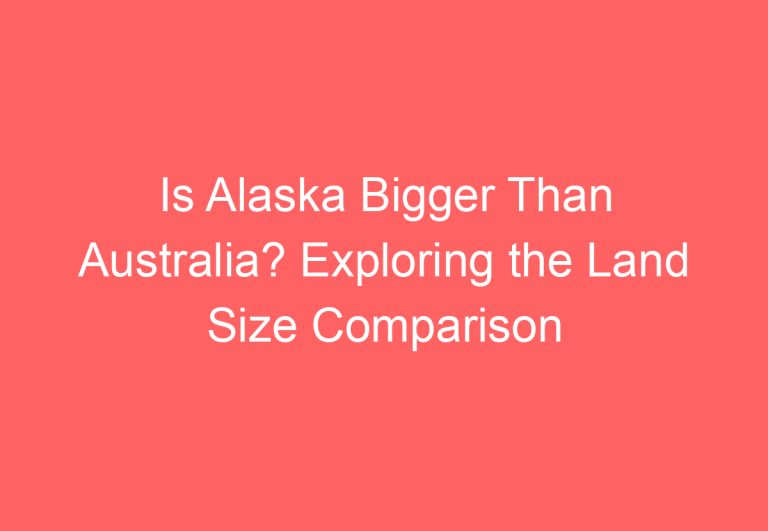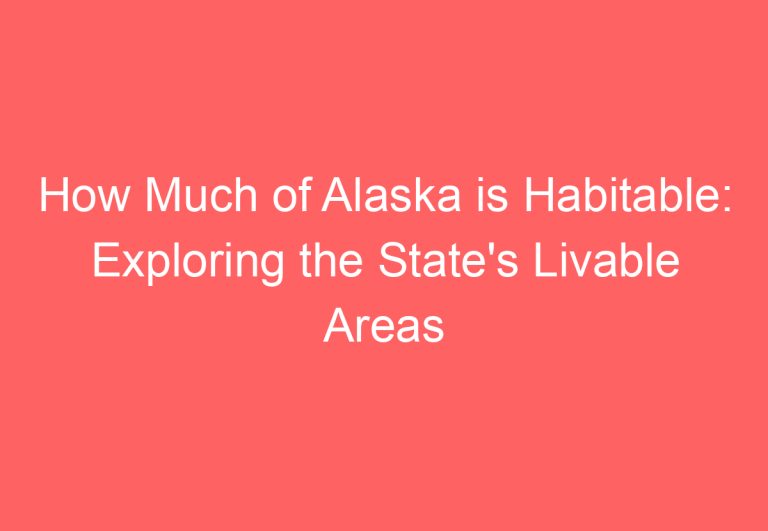Is Alaska an Island? Exploring the Geographical Facts
Alaska, the largest state in the United States, is a land of vast wilderness, rugged terrain, and stunning natural beauty. It is known for its towering mountains, sprawling glaciers, and abundant wildlife. However, there is a common question that arises among people about Alaska’s geography: Is Alaska an island?

The answer to this question is no, Alaska is not an island. It is a state located in the extreme northwest corner of North America, bordered by Canada to the east, the Arctic Ocean to the north, and the Pacific Ocean to the west and south. While Alaska is not an island, it does have many islands within its borders, including the Aleutian Islands, Kodiak Island, and Prince of Wales Island, to name a few.
Despite not being an island itself, Alaska’s geography is heavily influenced by its proximity to water. The state has over 6,600 miles of coastline and is home to numerous fjords, bays, and inlets. Additionally, many of Alaska’s communities are only accessible by boat or plane, further emphasizing the state’s relationship with the sea.
Geography and Landscape

Alaska’s Geographic Position
Alaska, the largest state in the United States, is located in the extreme northwest corner of North America. It is separated from the contiguous United States by Canada. The state shares maritime borders with Russia to the west, across the Bering Strait. The state’s Aleutian Islands extend westward from the southern tip of the Alaska Peninsula, forming a chain that separates the Pacific Ocean from the Bering Sea.
Major Landforms and Water Bodies
Alaska’s landscape is diverse and includes mountains, glaciers, forests, tundra, and coastline. The state is home to several major landforms, including the Brooks Range, the Alaska Range, and the Wrangell Mountains. The Brooks Range runs east to west across northern Alaska, while the Alaska Range runs east to west across the southern part of the state. The Wrangell Mountains are located in the eastern part of the state, near the border with Canada.
Alaska is also home to numerous water bodies, including the Gulf of Alaska, the Pacific Ocean, and the Bering Sea. The state’s coastline is over 6,600 miles long and includes the Inside Passage, a network of waterways that provides a protected route for ships traveling between Washington State and Alaska. Alaska is also home to several fjords, including Prince William Sound, which is home to several glaciers.
The state’s landscape is shaped by permafrost, which covers much of the state’s interior. Permafrost is a layer of soil and rock that remains frozen year-round, and it can be found as deep as 1,500 feet in some areas. The state’s mountains are also home to several active volcanoes, including Mount Redoubt and Mount Spurr.
Overall, Alaska’s geography and landscape are unique and diverse, and they are a major part of what makes the state so special. The state’s national parks and wilderness areas are popular destinations for visitors who want to experience the beauty and majesty of Alaska’s natural wonders.
Culture and History

Indigenous Peoples and Languages
Alaska has a rich history of indigenous peoples, with a variety of different cultures and languages. The Aleut, Tlingit, Eyak, Haida, and Tsimshian are just a few of the many indigenous groups that have called Alaska home for thousands of years. These groups have their own unique languages, traditions, and beliefs, and have played an important role in shaping the culture of the state.
Historical Events and Settlements
Alaska has a long and fascinating history, with many important events and settlements that have shaped the state into what it is today. In 1741, Russian explorer Vitus Bering landed on the mainland of Alaska, and the area was eventually settled by Russian fur traders. In 1867, the United States purchased Alaska from Russia, and it became a territory in 1912.
During World War II, Alaska played a key role in defending the United States from Japanese invasion, and many military installations were built throughout the state. After the war, Alaska experienced a boom in tourism, as people from around the world came to see its stunning natural beauty and unique culture.
Today, Alaska is home to many vibrant communities, including Dillingham, Haines, the Kenai Peninsula, the North Slope, Petersburg, Sitka, Skagway, Dutch Harbor, Bethel, Kodiak Island, Nome, and Yakutat. The state is also home to a thriving tourism industry, with visitors from all over the world coming to experience its natural wonders and rich cultural heritage.
Throughout its history, Alaska has been shaped by many different influences, from its indigenous peoples to its Russian and American settlers. Today, it remains a unique and fascinating place, with a rich culture and history that continues to inspire and captivate people around the world.
Frequently Asked Questions

What is the geographical connection between Alaska and Canada?
Alaska is the largest state in the United States and is located in the northwest corner of North America. It is bordered by Canada to the east, the Arctic Ocean to the north, and the Pacific Ocean to the west and south. Alaska is separated from the rest of the United States by Canada.
How many islands are part of Alaska?
Alaska has over 2,500 named islands, making it the state with the most islands in the United States. The largest islands in Alaska are Kodiak Island, Prince of Wales Island, and Admiralty Island.
In which country is Alaska located?
Alaska is a state of the United States. It was purchased from Russia in 1867 for $7.2 million and became the 49th state of the United States in 1959.
What is the population of Alaska?
As of 2021, the estimated population of Alaska is around 731,545 people. The largest city in Alaska is Anchorage, which has a population of around 291,538 people.
Can you list some major islands in Alaska?
Some of the major islands in Alaska include Kodiak Island, Prince of Wales Island, Admiralty Island, Baranof Island, and the Aleutian Islands.
Why is Alaska not considered a peninsula?
Although Alaska is connected to the North American continent, it is not considered a peninsula because it is separated from the rest of the continent by Canada. Additionally, the Aleutian Islands extend westward from the mainland, further separating Alaska from the rest of North America.






